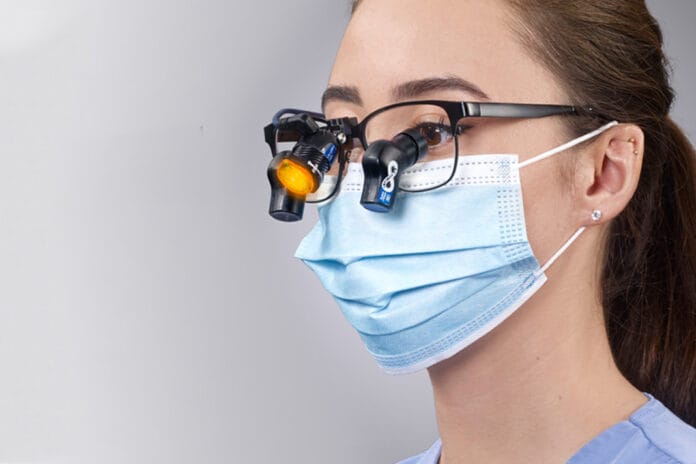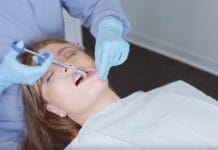Disclosure: This quiz is sponsored content from Designs for Vision as part of our sponsored partner program.
Win a Pair of Infinity VUE™ Loupes & an HDi Headlight from Designs for Vision!
Enter to win a pair of Infinity VUE™ Loupes & an HDi Headlight from Designs for Vision after taking this quiz! Designed to provide a straight forward approach to ergonomics, Infinity VUE™ loupes are available in 3.0x, 3.5x and NEW 4.5x magnification. Infinity VUE™ (Vision Up Ergonomics) keeps your chin up, your neck straight and your eyes forward while viewing the magnified surgical field.
To enter to win, simply fill out the form after taking the quiz! One lucky winner will be randomly selected on our about July 1, 2023, and notified shortly thereafter!
Now let’s test your ergonomics and musculoskeletal disorders knowledge!
Test Your Ergonomics and Musculoskeletal Disorders Knowledge
1. Ergonomics aims to reduce stress and eliminate injuries and disorders associated with the overuse of muscles, bad posture, and repeated tasks.
Ergonomics is the science of “fitting workplace conditions and job demands to the capability of the working population.” The aim of workplace ergonomic programs should be to prevent and/or control injuries and illnesses by eliminating or reducing worker exposure to work-related musculoskeletal disorder (WMSD) risk factors.
Risk factors associated with WMSDs include awkward postures, repetition, force, mechanical compression, vibration, temperature extremes, glare, inadequate lighting, and duration of exposure.
Work-Related Musculoskeletal Disorders and Ergonomics. (2020, February 12). Centers for Disease Control and Prevention. https://www.cdc.gov/workplacehealthpromotion/health-strategies/musculoskeletal-disorders/index.html
2. Awkward postures most frequently identified among dental professionals include which of the following?
The authors of an umbrella review published in 2018 found static posture among dental professionals was strongly responsible for the etiology of musculoskeletal disorders (MSDs). The most frequent awkward postures that were identified in the review included the following:
- Extreme forward head and neck flexion
- Trunk inclination
- Trunk rotation toward one side
- Lifting one or both shoulders
- Increased curvature of the thoracic vertebral column
- Incorrect positioning of the lower limbs with a thigh-leg angle of less than 90 degrees
De Sio, S., Traversini, V., Rinaldo, F., et al. Ergonomic Risk and Preventive Measures of Musculoskeletal Disorders in the Dentistry environment: An Umbrella Review. PeerJ. 2018; 6: e4154. https://doi.org/10.7717/peerj.4154
3. Which is an abnormal posture that refers to specifically altered muscle activation patterns, altered movement patterns, and postural deviation?
Upper crossed syndrome (UCS) is an abnormal posture that refers to specifically altered muscle activation patterns, altered movement patterns, and postural deviation. It occurs when the neck, shoulders, and chest muscles become deformed, usually due to poor posture.
Symptoms of UCS include:
- Neck pain
- Headache
- Weakness in the front of the neck
- Strain in the back of the neck
- Pain in the upper back and shoulders
- Tightness and pain in the chest
- Jaw pain
- Fatigue
Lower back pain restricted movement in the neck and shoulders
Young, B. (2018, September 18). Upper Crossed Syndrome. Healthline. https://www.healthline.com/health/upper-crossed-syndrome
Seidi, F., Bayattork, M., Minoonejad, H. et al. Comprehensive Corrective Exercise Program Improves Alignment, Muscle Activation and Movement Pattern of Men with Upper Crossed Syndrome: Randomized Controlled Trial. Sci Rep. 2020; 10: 20688. https://www.nature.com/articles/s41598-020-77571-4
4. The weight of the average human head is between 10 and 14 pounds. As the head tilts forward, no added force is placed on the neck.
The average adult head weighs between 10 and 14 pounds in a neutral head position. However, as the head tilts forward, the force to the neck dramatically increases depending on the degree of downward head tilt. A downward head tilt of 15 degrees increases the force placed on the neck to 27 pounds. As the head further tilts down, 40 pounds of force is placed on the neck at a 30-degree neck tilt, 49 pounds at 45 degrees, and 60 pounds at 60 degrees.1
Forward head posture and neck flexion can cause damage to the muscles in the neck and upper back, which can increase the risk of MSDs. The best way to avoid this is through preventive ergonomic measures, such as using magnification loupes.2
With standard loupes, the average head tilt is about 20 degrees. However, this adds at minimum 13-17 pounds of weight for your muscles to hold in a static position. Conversely, Designs for Vision Infinity Vue loupes allow the clinician to keep the head, neck, back, and shoulders completely upright, reducing added muscle strain. This upright head position increases the working distance by 4-5 inches. Because your working distance and position are further from the patient, higher magnification is required. Infinity Vue loupes are available in 3.0x, 3.5x, and 4.5x magnification to compensate for the increased working distance.1,3
1. Hansraj, K.K. Assessment of Stresses in the Cervical Spine Caused by Posture and Position of the Head. Surgical Technology International. 2014; 25: 277-279. https://pingeprii.ee/wp-content/uploads/2016/09/Hansray-K.K.-Assessment-of-Stresses-in-the-Cervical-Spine-Caused-by-Posture-and-Position-of-the-Head.pdf
2. Soo, S.Y., Ang, W.S. Chong, C.H., et al. Occupational Ergonomics and Related Musculoskeletal Disorders among Dentists: A Systemic Review. Work. 2023; 74(2): 469-476. https://pubmed.ncbi.nlm.nih.gov/36278379/
3. Infinity VUE Loupes. (n.d.). Reality Ratings & Review. https://www.designsforvision.com/REALITY/InfinityVUE-FirstLook.pdf
5. For how many decades has there been no significant improvement in the trend of musculoskeletal disorders among dental professionals?
Over the past three decades, there has been no significant change in the trend of MSDs among dental professionals. This indicates a consistently higher prevalence, highlighting the need for better ergonomics in practice and in dental and dental hygiene school curricula.
Chenna, D., Pentapati, K.C., Kumar, M., et al. Prevalence of Musculoskeletal Disorders among Dental Healthcare Providers: A Systematic Review and Meta-analysis. F1000Research. 2022; 11: 1062. https://doi.org/10.12688/f1000research.124904.2
6. There is no significant difference in pain associated with MSDs reported by experienced dental hygienists and dental hygiene students.
A study published in 2020 found no difference in the prevalence of pain associated with MSDs among experienced dental hygienists and dental hygiene students. In this study, the participants reported MSDs primarily in the neck (60%), upper back (52%), and lower back (61%). The study concluded that not only are experienced dental hygienists at an increased risk of developing MSDs, but dental hygiene students also have the same risk level before they have even graduated and started practicing.
Netanely, S., Luria, S., Langer, D. Musculoskeletal Disorders among Dental Hygienists and Students of Dental Hygiene. International Journal of Dental Hygiene. 2020; 18(2): 210-216. https://doi.org/10.1111/idh.12428
7. The long-term use of magnification loupes weakens eyes over time.
“There is no evidence that long-term use of magnification for close work carries any risk for the majority of individuals. Optometrists agree that using loupes routinely does not harm or weaken eyes, nor does it cause the user to be compromised in any way.”1
Called presbyopia, the loss of visual acuity and the ability to see things close-up is age-related and tends to begin at the age of 40. Dental professionals that suffer from presbyopia can maintain the same working distance when loupes are consistently used, even as their vision changes due to age-related declines. This will help maintain a comfortable upright position with less muscle strain and musculoskeletal damage from poor posture or awkward positions.1
“Optical aids should be used early enough to compensate for visual deficiencies and ensure that the best conditions are employed for good quality of dental work.”2
1. James, T., Gilmour, A.S. Magnifying Loupes in Modern Dental Practice: An Update. Dental Update. 2010; 37(9): 633-636. https://www.researchgate.net/publication/49703900_Magnifying_Loupes_in_Modern_Dental_Practice_An_Update
2. Perrin, P., Ramseyer, S.T., Eichenberger, M., Lussi, A. Visual Acuity of Dentists in their Respective Clinical Conditions. Clin Oral Invest. 2014; 18. https://www.researchgate.net/publication/259989144_Visual_acuity_of_dentists_in_their_respective_clinical_conditions











